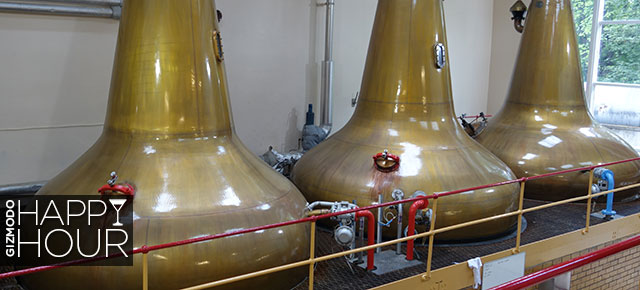Among connoisseurs, scotch whisky is heralded as a complex delicacy. Listen in on a tasting: You’ll swear they’re describing an entire dinner entree, not a sip of booze. But scotch distillers need only three ingredients — and a barrel-full of technique — to make that magical elixir, as I learned while touring the Aberlour distillery in Scotland.
The folks at Aberlour wanted me to tour their distillery so badly, they flew me to Scotland and housed me and four other writers in an achingly gorgeous old inn for three days, plying us with fine food and life-giving elixirs for the duration. It’s a tough job.
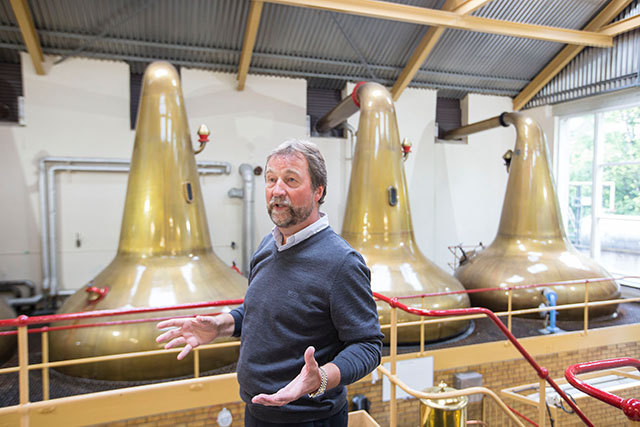
Master Distiller Douglas Cruickshank. Photo by John Paul.
Aberlour’s master distiller, Douglas Cruickshank, was our spirit guide on this journey, introducing us to the trinity that goes into every bottle of single malt: water, barley, and wood. It’s an ancient technique that was born right here in the Speyside region of Scotland, but whose ingredients and products now span the globe.
The Water
Every bottle of whisky starts with a proper source of water. Aberlour’s comes from a natural spring, fed by meltwater from the snow-capped Ben Rinnes mountains. This water trickles through pink granite deposits, collecting a characteristic clutch of minerals as it winds its way down to the Aberlour distillery’s private spring.
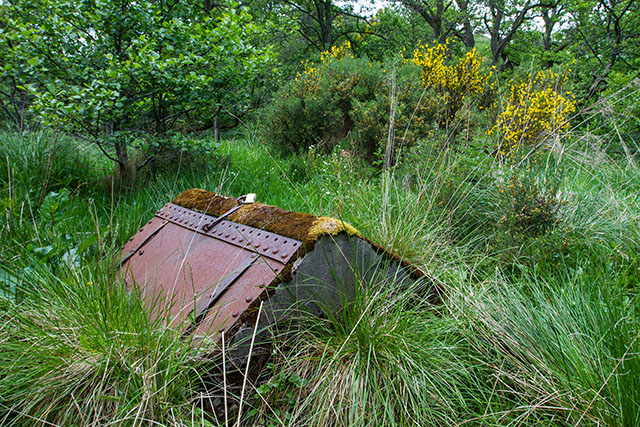
This cap covers the natural spring supplying the water that goes in every bottle of Aberlour scotch. Photo by John Paul.
That spring water is naturally soft, devoid of any metallic elements that could taint the flavour of the whisky. The mineral content is left undisturbed, giving the water a light sweetness at the center of every Aberlour variety. Each of the distilleries in this region draws from a different spring or stream, giving each brand a unique flavour.
In fact, water is what helped establish this as a signature scotch-making region. Both Aberlour (the village) and Aberlour (the distillery) were named in honour of the Lour burn, or stream, which flows past the distillery and whose water cools the stills at the center of the whisky-making process. South of the town, the Lour bubbles into the Spey river, upon whose banks the Speyside whisky making tradition was born. Today, the region hosts nearly half of all the distilleries in Scotland, including names any scotch drinker will recognise.
Whisky is often referred to as “the water of life,” and here it’s no exaggeration: In this valley, distilling has been a way of life for centuries. As Douglas led us through the many different steps that go into making a bottle of scotch, we came across enough second- and third-generation whisky workers, I wondered if the skill is passed down genetically.
One night during our stay, another journalist and I took an evening stroll into the village of Craigellachie where we were staying. Not a quarter mile from our hotel, we turned a corner and found ourselves facing a Dewar’s distillery, maker of perhaps the most ubiquitous mid-range scotch in the U.S. The next morning, we learned that an equally short jaunt in the opposite direction would have run us into the birthplace of Macallan, one of the world’s top-selling single malts. At times, the “whisky trail” seems short enough to cover on foot.
The Barley
Soft, mineral-rich spring water is lovely, but without the addition of grain, all it will do is keep you hydrated. Scotch whiskies are built on malted barley: dormant seeds revived with spring water, then laid on stone to sprout, producing the sugars, starches, and enzymes needed to fuel fermentation.
Once the grain has sprouted, the malters halt germination by drying the barley. While some whisky makers dry their malt over a peat fire, giving the final product a trademark smokiness, Douglas scoffed at the idea. “Aberlour doesn’t use peat,” he said. “We don’t want that reek, that smoke.”
The malt arrives at the distillery in 12-ton batches. There, it’s run through a three-story-high mill, the first of many industrial-size apparatus we saw on our tour. The mill grinds the malt into grist, a fine flour-like powder. “This is the most important part for efficiency,” Douglas explains. “If you don’t get the grind right, you’ll never recoup in the next parts.”

Efficiency is a theme in every step of the scotch-making process. That helps profits, obviously, but it’s also a buffer against the unpredictable swings that can happen in supply chain that feeds the whisky business. “The cost of raw materials fluctuates horrendously,” Douglas explains. “The barley may not even be in the ground yet and we’re looking at the outcome for that crop.” Early Scottish distillers chose barley for their feedstock because they had plenty of it lying around; today, law and centuries of stern tradition forbid that recipe from changing, so distillers have to sweat the details of the seasonal crop.
Once the malt is milled, it’s mixed with warm spring water to create mash, a slurry that’s sent into the next room and a giant, three-story vat called the mash tun. The mash infuses for 25 minutes, allowing the enzymes activated during the malting process to convert the barley’s starches into sugar. Each 12-ton batch of mash is soaked three times, making a clear solution called sweet wort. The third soak gets recycled, becoming the first soak of the next batch of mash. Maximum extraction, with minimal waste.
The sweet wort gets sent to another giant vat called the washback. Standing on the metal grate floor next to the washback’s manhole-sized hatch, we were hit with a heady aroma that’s immediately familiar to anyone who was once 18 to 21 years old: the warm beer smell of a sun-baked frat house. This is the chamber where the yeast is added to the sweet wort, and after 48 hours at just a touch below 70 degrees, the wee beasties have turned the wort into wash, a beery, 8.5 per cent alcohol brew.
We followed the wash into the next room, the centrepiece of the distillery: The stills, four mammoth copper kettles with broad, bulbous bases and tall, tapered necks. The towering, elongated shape is a purposeful design choice — the taller the still, the more impurities are driven out during distillation, creating the softer, lighter flavours that distinguish Speyside style whisky. Each wash is distilled twice; “Ireland prefers triple-distillation,” Douglas says, in a tone you’d use to describe an eccentric cousin who runs the dishwasher twice for each load.
The first distillation goes through the wash still, which drives off enough water and impurities to raise the alcohol content to a shade over 20 per cent. This condensed “low wine” then runs through the spirit still, which turns the wimpy wine into high-powered jet fuel. The first and last portion of what comes out of the still (known as the foreshot and feint, respectively) are too tainted with impurities to be useful. The middle portion, however, is the 62-to-73-per cent alcohol sweet spot. Armed with a hygrometer, the stillman diverts the foreshot and feint back into the still for purification. The good stuff, called new make, is what the master distiller’s looking for: clear, pure, and powerful.
Colorless new make coming out of the still through the spirit safe, a locked inspection chamber invented in the 1800s to prevent siphoning off alcohol before it could be measured and taxed.
The Wood
The new make definitely passes for liquor — the clear spirit packs a hint of berry sweetness and a punch that could make the uninitiated’s eyes water — but it isn’t yet scotch. “You can’t call it whisky until it’s been matured in oak for three years,” Douglas told us. “That was a law passed in Scotland during World War I; they figured that ageing the product for three years would prevent drunkenness during the war effort.”
There’s another obscure law that has a huge effect on scotch whisky making, one enforced 2,000 miles away in the United States. Ever since the end of Prohibition, federal regulation states that bourbon can only be aged in new oak barrels. Once those bourbon casks are emptied, they’re no longer useful to U.S. distilleries; but in Scotland, they yearn for these well-seasoned oak vessels.
“The law was put in place to protect loggers and coopers,” Douglas told us, “so the U.S. makers have a surplus of barrels made from seasoned wood that’s now optimised for scotch.”
He cracked a wry smile. “They’re cleaning out the wood for us.”
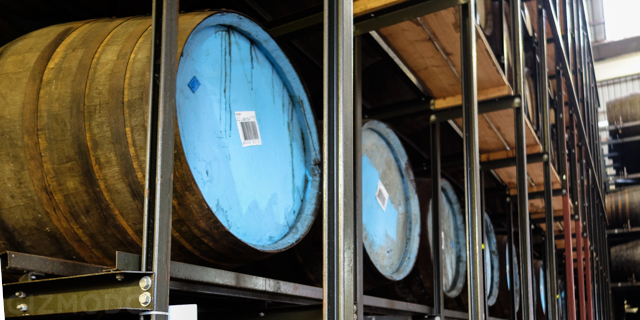
In Scotland, distilleries can use the barrels as many times as they like, but not every barrel comes to the country in whisky-ready shape. Just up the road from Aberlour’s distillery is Speyside Cooperage, a workshop where master coopers repair and restore these oak casks, readying them for their precious cargo. The cooperage, like the distillery, is home to a time-honored craft that’s only barely been touched by modern technology.
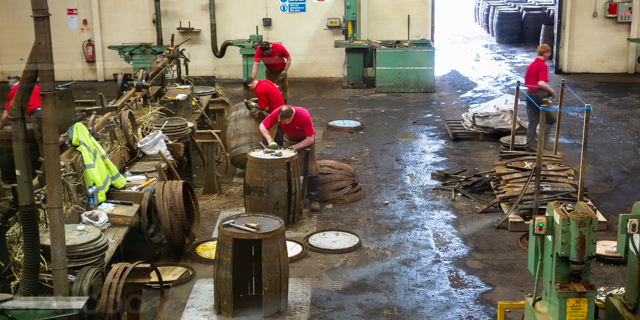
With casks coming from around the globe, any disruptions in the market can seriously throw off the whisky market. For a while, U.S. bourbon distilleries could get more money selling used barrels to companies that cut them in half and made them into outdoor furniture and decorative pieces. That meant fewer barrels for scotch distilleries, driving supply down and prices up. Next time you gasp at the price of a good bottle of whisky, blame your neighbour with the quaint wooden lounge chair.
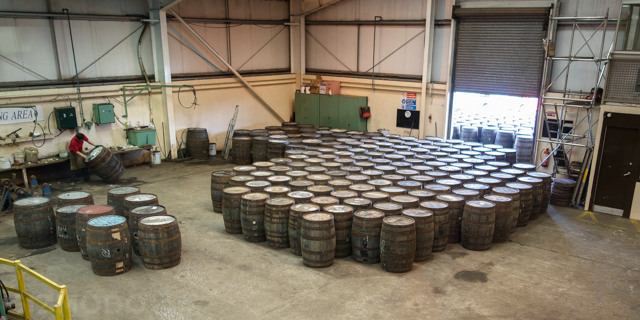
The casks are as essential to the final product as the water or barley. “If you put high quality spirit in a bad cask, you’ll get crap,” Douglas told us. Finding the right casks is a task in itself: he personally “noses” every cask Aberlour buys, checking the wood’s aroma to make sure it won’t turn the new make sulfury or sour. “There’s no such thing as a test,” Douglas told us. “You just have to know what you’re looking for.”
Aberlour opts for two varieties of casks: bourbon barrels from the U.S., and sherry butts from makers of Oloroso, a fortified wine local to Jerez in the south of Spain. A full 70 per cent of a scotch’s flavour, and all of its colour, comes from the barrel — both the contents of the wood, and the remaining liquor or wine that soaked in during previous ageing.
Over the course of years and decades, the new make moves in and out of the wood, picking up the memories of the bourbon or sherry the cask once contained. Most of Aberlour’s range of whiskies contain a blend of spirit aged in either the wine or the bourbon casks. The bourbon-infused wood creates sweet, smooth-drinking flavours like vanilla and coconut, while the wine casks impart rich, fruity, spicy flavours and a robust amber colour.
The only exception to this is Aberlour A’bunadh (rhymes with “a tuna”), aged exclusively in ex-Oloroso wood and bottled at cask strength. This particular water of life is powerful stuff: of all the varieties of Aberlour we tried on this trip (again, it’s a taxing job), the A’bunadh has by far the most robust flavour and aroma. It’s not at all harsh — it’s that wonderfully elusive mix of smooth and strong — but it’s definitely not something you drink absent-mindedly. A’bunadh demands, and rewards, full concentration.

At the pub after our first day on the trip, the guests around the table all chose their Aberlour varieties — mostly 18 year with a few A’bunadh mixed in — then listened with lightly-masked anticipation to see what Douglas, the master distiller, would order.
He opted for 12 years, the youngest whisky Aberlour offers. As the waiter walked away, Douglas turned to the table and, with the mildest of flourishes, said, “it’s hard to improve on perfection.”
